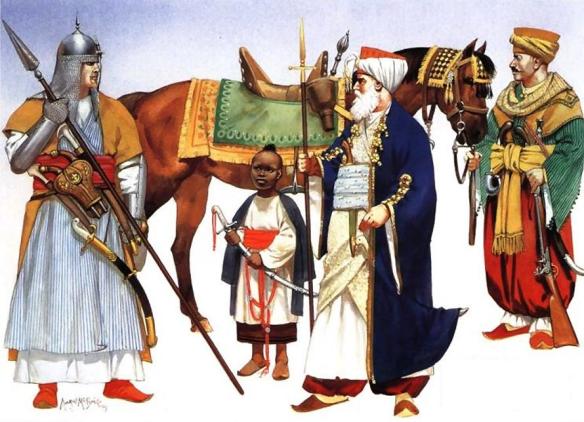‘‘Mamlūk’’ meant ‘‘owned,’’ or ‘‘slave,’’ with the special connotation of ‘‘Caucasian military slave.’’ This was because most early Mamlūks were Central Asian-Turkic or Caucasus slaves who were imported to Syria and Egypt by the Abbasid caliphs of Baghdad to reinforce Arab tribal levies which were losing their military edge, and reputation, within the Arab empire. By convention, ‘‘Mamlūk’’ refers to the dynasty and military elites while ‘‘Mamlūk’’ is used for ordinary slave soldiers. By the 9th century the Abbasids accepted annual shipments of Mamlūks as tribute. A major expansion of Mamlūk service followed as Turks displaced Arabs and Iranians from military service within the caliphate. As the Muslim states became increasingly military rather than civilian-religious empires, Turkic-speakers and soldiers became the predominant political class—a position they retained in the Middle East for a thousand years. In 868 a Mamlūk dynasty was founded in Egypt, the first breakaway state from the unified empire of the caliphs. In Iran, too, Turkic-speaking slave soldiers dominated, culminating in the military slave dynasty of the Ghaznavids (962–1186). The Umayyad Caliphate in al-Andalus, with its capital at Córdoba until the early 11th century, employed northern and western European slaves captured as boys, castrated, and trained as Mamlūks. A Mamlūk dynasty ruled large parts of northern India for a time after 1206, but it was always weaker than its Middle Eastern counterparts as it lacked a ready source of new recruits. Training fell by the wayside and the Indian Mamlūks were compelled to share power with local civilians. A new bevy of Mamlūks were brought to Egypt by Salāh al-Dīn (Saladin, 1137–1193), who pushed aside the last Berber Fatamid caliph to rule in his name, then put his family on the sultan’s throne as the Ayyubid dynasty. He relied heavily on loyal Mamlūk soldiers. After crushing a Crusader army under Louis IX, a rebellion led by the Mamlūk general Baybārs overthrew and murdered the Ayyubid sultan, Turan Shah. The Ayyubids tried to elevate a female sultan— Shajar al-Durr—as a replacement but this garnered wider support for the rebels from Muslims who could not conceive of being ruled by a woman. Mamlūk-governed Egypt is conventionally periodized as the Bahri (River) Mamlūk era, 1250–1382, and the Burji (Citadel)Mamlūk period, 1382–1517.
In 1260 the Mamlūks defeated the Mongols in Galilee at Ayn Jālut. The next year the remnant of the Abbasid caliphate moved to Cairo (from Baghdad, which succumbed to the Mongols in 1258). This did not alter the fact of rule by Mamlūk sultans over Egypt and Syria. The Mamlūks actually benefitted from Mongol disruption of northern trade routes, which diverted goods into Mamlūk ships plying the Indian Ocean and Red Sea. The Mamlūks crushed the last Crusader state, besieging and storming Acre (including with suicide squads) in 1291. After that defeat, the Latins surrendered Tyre and all other strongholds without further fighting. To the south, the Mamlūks expanded into Alwa in southern Nubia, pushing that Christian state to relocate deeper south after 1316. Having tamed the last of the Crusaders, the Mamlūks governed Palestine and Syria until 1400, when they were beaten at Aleppo by Timur and Syria was lost to them. It was not recovered until Timur’s unstable empire fell apart after his death.
Timur’s unstable empire fell apart after his death. Since the children of Mamlūks were originally forbidden to become knights, the Mamlūk dynasty continually drew fresh supplies of Turkish-Russian slaves to renew military formations. This meant that the language of the Mamlūk ruling class was Turkic, with many slave soldiers also unable to speak Arabic. The later Mamlūk system was semi-feudal: an officer was granted land from which he drew revenue (he still lived in barracks in Cairo) to sustain himself and perhaps some soldiers, too. By this time recruitment had changed, so that Mongols, Circassians, Greeks, Turks, and Kurds were also to be found in Mamlūk barracks. After 1383 the Mamlūk sultans were usually also the main commanders. Although they sometimes trained as lancers and could fight as medium-to-heavy cavalry, the Mamlūk military specialty was mounted archery. They were trained to hit a small circular target at 75 yards’ range, five shots out of five, and to loose arrows at a pace of 6 to 8 per minute. They were originally formed to fight nomadic light cavalry and trained to equal or best the Bedouin in the skills of mounted archery. When fighting was hand-to-hand, heavier Mamlūk armor and weapons and superior discipline and training meant they usually prevailed. This militarily conservative system was superb and effective against the normal threats faced by Egypt: Bedouin from the desert, North African nomadic warriors, and distant Nubians. It remained to be tested against more modern forces gathering to the north in the Ottoman Empire.
